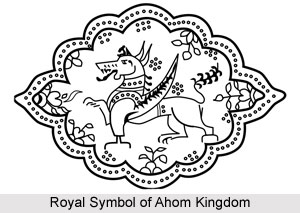 Supangmung, also known as Chakradhwaj Singha, was a significant ruler of Ahom kingdom. He owns the credit of taking back Guwahati from the Mughal dynasty. He was also extremely proud of being the Ahom monarch. His reign continued from 1663 to 1670 AD.
Supangmung, also known as Chakradhwaj Singha, was a significant ruler of Ahom kingdom. He owns the credit of taking back Guwahati from the Mughal dynasty. He was also extremely proud of being the Ahom monarch. His reign continued from 1663 to 1670 AD.
Coronation of Supangmung
Ahom king Jayadhawaj Singha, popular as Sutamla, had no sons and thus the Saring Raja was brought by the nobles to rule over the kingdom. He was the grandson of Suleng Deoraja (a former Saring Raja), the cousin of Jayadhwaj Singha and also the second son of Suhungmung. The Deodhais of the kingdom named him Supangmung. He had however also adopted a Hindu name Chakradhawaj Singha. During his coronation, an envoy was sent by the Jaintia Raja to congratulate the king. The Koch Raja of Darrang also did the same for restoring amicable relations with the Ahoms, after his support to Mir Jumla in his invasions, which led to their hostile relations. A robe of honour, known as `khelat`, was presented by the Mughal Emperor Aurangzeb to the Ahom king and it was insisted to the king to put it on in presence of the envoys. This was taken as a humiliation by Supangmung.
Expedition of Supangmung against Mughals
At the beginning of his reign, Supangmung started the repair work of the forts situated at Patakallangand and Samdhara and restored the efficiency of his army. In the year 1665 the king decided to recapture the western Assam by expelling Mughals from this region and assembled the nobles and ministers to device plans in favour of this. In early 1667, he received a strong worded letter by Saiad Firuz Khan, the successor of Rashid Khan as Thanadar of Guwahati, for the payment of indemnity balance which was outstanding. After receiving the letter Supangmung strongly decided to battle against Mughals.
By August 1667, the Ahoms completed their preparation for the expedition against the Mughals and well equipped soldiers were sent for the mission under the commandership of Lachit Borphukan. The commanders of the mission were given valuable gifts by the king. On 2nd November 1667, Ahoms succeeded in capturing Itakhuli along with the contiguous garrison of Guwahati. They seized the horses, elephant, coins, guns and other artefacts belonging to the imperial stores of Guwahati. Afterwards they chased the Mughals up to the Manas River which was the former boundary of Assam and Mughal India. The Ahom army also succeeded in setting the Assamese captives free from the clutches of Mughal Empire, who were imprisoned since the expedition of Mir Jumla. Thus, owing to the determination of Supangmung, within two months, the Ahoms once again recovered their lost territories and regained their glory and prestige.
Administration of Supangmung
People of Ahom kingdom regarded Supangmung as the ideal monarch who bestowed energy and inspiration on the people. On the other hand, Lachit Barphukan, also considered himself fortunate enough for having him as the king of the state. The self respect and patriotism possessed by this king was unmatched in the history of Assam. However at the start of his reign, he had suffered substantial shame due to the preceding regime. Supangmung himself supervised the preparations of his army for the expeditions. He himself trained the archers and ordered the army to proceed for the expedition when he felt satisfied with the preparations.
Supangmung also acquired the support and cooperation of neighbouring chiefs by sending those letters about his plans. Those letters clearly narrated his patriotism towards his kingdom. The best example of the intelligence and wisdom of Supangmung was evident in his selection of Lachit Barphukan as the commander of his army who succeeded in accomplishing the mission. In the expedition, his Prime Minister Atan Burhagohain, who was known to be an adept soldier, a military engineer and a diplomat, was also sent to accompany the commander. When all the best folks of his kingdom were sent to the expedition, Supangmung smoothly managed the internal affairs of the kingdom. The king also gave logistic support to his army by providing those arms, food and men from his capital.
After capturing Guwahati, Supangmung organized and streamlined the system of administration and revenue collection of lower Assam which was supervised by senior officers, Rajkhowas and Phukans. His systems were greatly influenced by the Mughals. The king also maintained efficiency in civil administration of the country.
Death of Supangmung
The long war had greatly exhausted Supangmung, both physically and mentally and in April 1670, a year before the battle of Saraighat, he died. Unfortunately the king could not see his ultimate victory at the battle of Saraighat that led to the end of the plans of Mughals to expand their territory towards eastern India.



















